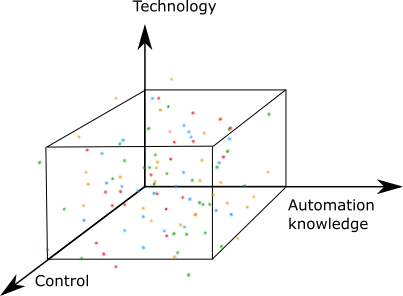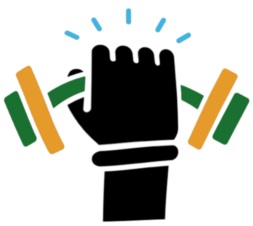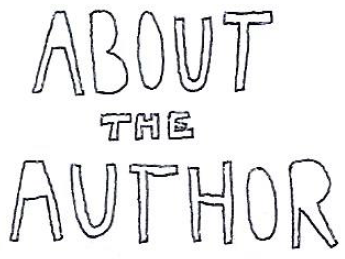We encounter a range of document automation experience in our engagements with prospective customers. We might generalize their underlying business driver as “better document processes”, but not what they do and what they know.
Our potential clients' existing automation knowledge and experience sits on a continuum from “none” to “nearly everything”. Overlay a second continuum of technology on a similar scale, and a third continuum of control ranging from minimal to maxed-out prescriptiveness.
In fact, “overlay” hardly does justice to the structure. Better to represent each continuum as an axis on a 3-D chart, to create a cube with a scatter mapping of processes. Those, taken as a whole, could touch any continuum at multiple points.

Mapping processes to technology, knowledge, and control
There is more: the technology continuum only quantifies. It does not qualify the actual technology, which may be any combination of bespoke solutions created by or for the customer, and third party products ranging from simple MS Word automation to full packages.
Thus, each document process uniquely combines automation, control, and aspects of technology; a tidy summary but over multiple processes it creates a complex overall picture. Where to begin?
Look to core strengths, then “Play to your core strengths”.
Generically meaning anything from common sense to the elixir of happiness, we see it as a pragmatic approach to document automation.
We subscribe also to not biting off more than we can chew, good practical advice that supports playing to strengths, because trying to fix everything at once plays to no-one’s. The best outcomes spring from well-managed proofs of concept and sympathetic pilot projects and rollouts.
To address one specific issue: most organizations we work with are not in the business of software development. It is nowhere near their core strength, yet some will forge ahead and develop software solutions for document automation.
Credit where it is due: we have seen some very good, thoughtfully conceived, well-structured applications. Most occupy the middle ground. Few sit at the other extreme; they tend to drop out of use if they do not work.
The common theme, however, is the difficulty of maintenance and adaptation, to meet not only changing business needs but also the constraints and opportunities of evolving technology. To build and keep such applications, and the expertise they demand, requires the organization to invest significantly in non-core strengths.
We have written more on this subject, from various points of view including adaptation of specific technologies and the pros and cons of build vs. buy. We invite you to read our related whitepapers.
The core strength that your organization can most efficiently leverage is the “gold in the organization”; not only the gold content – as highlighted in the whitepaper “Smarter Content Reuse” by my colleague Martin Srubar – but also the institutional gold, the knowledge of your own processes embodied in the knowledge and expertise of your people.
We, in turn, bring our core strengths to the table: our genuinely fit-for-purpose and cost-effective software and, for even better value for money, our people and our experience. My day job at ActiveDocs is Senior Solution Consultant; I look forward to engaging with you.



